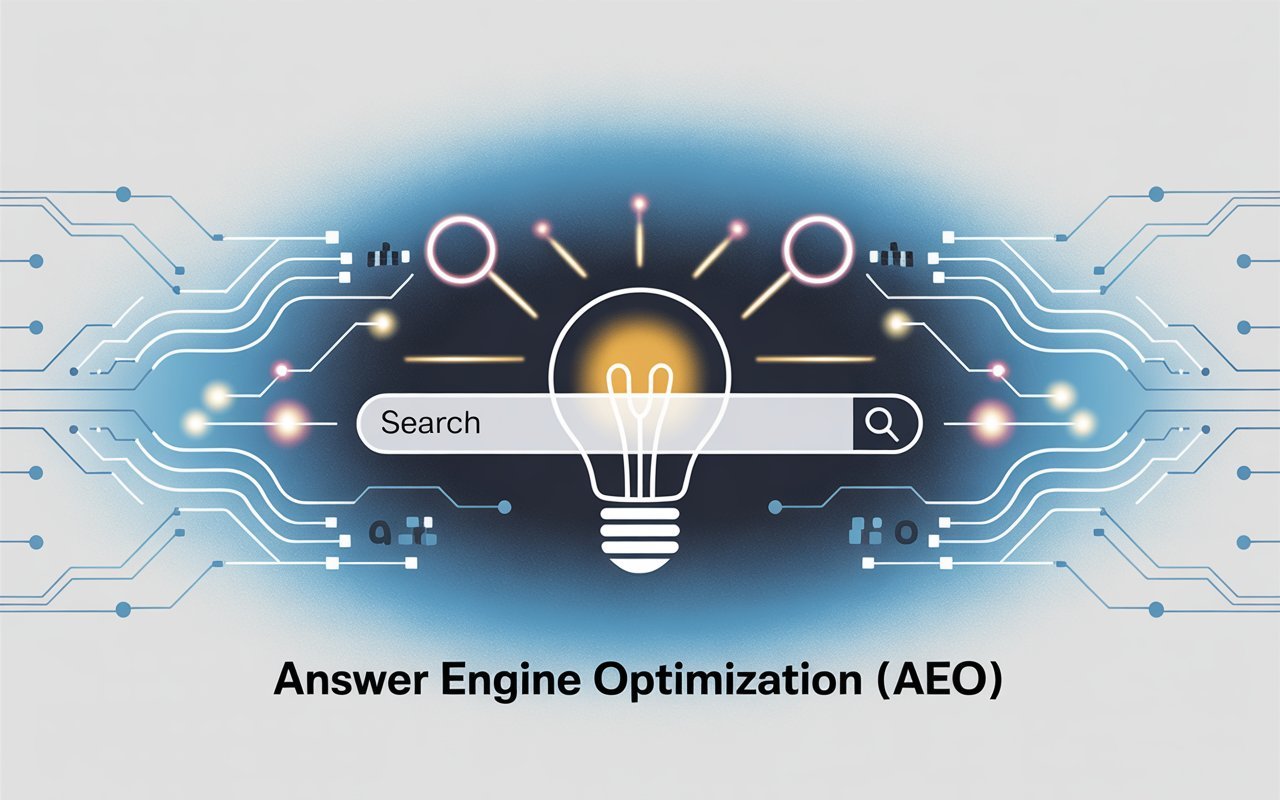
With the rise of AI search engines (like Google SGE and Microsoft Copilot) and conversational AI (such as ChatGPT), the search landscape is undergoing a dramatic evolution. This modification is changing how content is found and assessed, with AI now synthesizing, summarizing, and developing answers in real-time, surpassing basic keyword crawling. Comprehending Answer Engine Optimization (AEO) is paramount. You must drive beyond traditional SEO and adopt top-notch approaches to achieve high content visibility in this AI-generated environment. At RevoluteX Digital, we believe comprehending “What is Answer Engine Optimization?” and it has become crucial for modern SEO success. This article explores what is answer engine optimization? and how a user can optimize content for AI search in 2025 and beyond.
1. Learning the Objectives of AI-Powered Search
Before exploring specific tactics, you need to know how to optimize content for AI search. Users should understand the logic behind “What is Answer Engine Optimization?”
It has become crucial to understand the core motivations behind AI search:
AI searches prioritize directly fulfilling user necessities, often providing straightforward answers or summarized information.
Content Transformation:
AI tools don’t simply extract snippets as they synthesize information from various sources to create natural responses.
Clear and Credible Communication:
Incomplete or inaccurately structured content is unlikely to be prioritized.
Key Takeaway: You should focus on creating content that completely addresses user problems with clarity and context, rather than merely pointing out specific keywords.
2. Focus on Topics Over Keywords
Traditional SEO emphasizes keyword density and long-tail variations, while AI search prioritizes semantic relevance and the depth of topical coverage.
Key Method:
- Implement a Topic Cluster Model:
For this, you need to create a pillar page centered around a broad topic supported by detailed and interlinked blog posts exploring specific subtopics.
For Example, A “Digital Marketing” pillar page could associate to subpages on topics like “Email Campaign Best Practices,” and “AI-Driven SEO Approaches”.
- You should cover each topic thoroughly to verify your domain as an authoritative source in the eyes of AI standards.
- Incorporate Relevant Questions and Answers like “People Also Ask” to address common user queries.
Pro Tip: Utilize tools like AlsoAsked and Answer the Public to identify real user questions.
3. Structure Content for AI Comprehension
AI models excel at extracting structured, digestible information. The formatting of your content significantly impacts its selection by AI search engines.
Best Practices:
- Leverage H2s and H3s for Subtopics: Treat these headings as mini-headlines that directly answer specific questions.
- Incorporate Lists, Bullet Points, and Summaries: Enhance readability and facilitate information extraction.
- Front-Load Answers: Present definitions or direct responses at the beginning of each section, followed by explanations and examples.
- Maintain Short Paragraphs: Aim for paragraphs of 2-4 lines for improved readability. Therefore, it can be helpful in improving visibility in AI search results
Think of your content as an FAQ for machines: direct, organized, and easily scannable.
4. Embrace Natural Language and Conversational Phrasing
AI models are trained in natural, human-like language. Content that reflects how individuals communicate and ask questions is more likely to be concentrated.
Implementation:
- Adopt an Informal Tone: Use a conversational tone, particularly in introductions and conclusions.
- Mirror User Queries: Echo the user’s query in your response to establish relevance.
- User Query: “What is the best flooring for basements?”
- Content Answer: “The best flooring for basements is typically vinyl or engineered wood, because”
- Prioritize Readability: Avoid robotic keyword stuffing and focus on readability and engagement.
5. Implement Structured Data and Schema Markup
Structured data helps search engines and AI understand the context and format of your content, improving its chances of being featured in rich results, AI-generated answers, and voice search responses.
Utilize Schema Markup:
- FAQPage: For content answering common questions.
- HowTo: For step-by-step guides.
- Article/Blog Posting: For editorial content.
- Review: For product or service reviews.
Pro Tip: Users can employ gears like Google’s Structured Data Markup Helper.
6. Develop Trust Through E-E-A-T Principles
AI-powered search systems use Experience, Expertise, Authoritativeness, and Trustworthiness (E-E-A-T) signals to assess content quality.
Enhance Your E-E-A-T:
- Include Author Bios: Add author bios with credentials and links to professional profiles.
- Provide External Citations: Cite authoritative sources to support your claims.
- Share First-Hand Experiences: Incorporate first-hand experiences and relevant case studies.
- Keep Up-to-Date Content: Update your content to avoid penalties for outdated information.
Example: When writing about citing reputable sources like the NIH or Mayo Clinic, rather than depending solely on generic blogs.
7. Prioritize Direct Answers, Followed by Expansion
Since AI often generates answers to specific queries, your content should provide direct, concise answers, followed by more in-depth explanations.
Try this format:
- Q: How do you fix a vehicle in an emergency?
- A: “To fix a vehicle, you need to follow top-notch approaches do that you can get back on the track.”
Then elaborate with details on instruments, tips, and potential pitfalls.
Pro Tip: Consider embedding a dedicated FAQ section at the end of your articles for improved AI readability.
8. Make Content Multimodal-Ready
AI tools are increasingly leveraging images, videos, and charts to provide more effective answers to user questions.
Include:
- Infographics: Summarize key statistics visually.
- Diagrams: Explain complex concepts visually.
- Short Video Explainers: Or embed relevant YouTube content.
Why it Matters: AI can extract and cite visual elements, making your content more appealing and informative, especially for “how-to” or product-related queries.
9. Voice search optimization strategies
With the rise of voice-enabled AI search, your content needs to be concise and easily understood when spoken.
Tips:
- Write Short, Punchy Answers: Aim for answers of 20-30 words.
- Use Simple Sentence Structure: Improve clarity and comprehension.
- Avoid Jargon: Unless your target audience is highly technical.
- Consider Readability: Think about how your content would sound if read aloud.
10. Monitor AI Mentions and Adapt Accordingly
It’s now possible to track how AI tools are utilizing and citing your content.
Actionable Steps:
- Use AI Browsing Tools: Utilize tools like ChatGPT browsing or Google SGE preview to observe how AI is extracting information from your content.
- Track Mentions: Monitor brand and URL mentions across AI platforms.
- Update Underperforming Pages: Revise and optimize pages based on insights gained from AI analysis.
Remember: AI optimization is an ongoing process, not a one-time fix.
Final Thoughts
Optimizing for AI search requires aligning your content with the way people ask questions and the way AI tools provide answers. Emphasize depth, clarity, structure, and trustworthiness.
In the evolving landscape of AI search, success will belong to those who:
- Adopt a Holistic Approach to Topic Coverage: You must create comprehensive and interconnected content.
- Prioritize User Needs: A complete focus on providing value to real users.
- Facilitate Understanding: Structure content to be easily understood by both humans and machines.
RevoluteX Digital seeks to help clients that want to adapt to this new landscape of AI search. For high optimization, we understand that a key to thriving success is what is Answer Engine Optimization?. For this, we offer bespoke SEO strategies that align with succeeding in the age of AI, and we structure your content not only to be found but to be understood and quoted.
Jason
We are an Affordable Digital Marketing Agency in Shawnee with budget-friendly solutions to amplify your brand. Elevate your business without compromising quality or cost.
